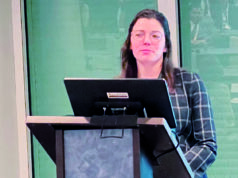
There is a stark downward trend in the number of U.S. centers in the Vascular Quality Initiative (VQI) that meet the Society for Vascular Surgery (SVS) clinical practice guidelines for open repair of abdominal aortic aneurysm (AAA), new research to be revealed at the 2021 Vascular Annual Meeting (VAM) finds. Data collected over an eight-year period suggest that patient access to guideline-conforming open repair was low to begin with and is steadily decreasing. The research is likely to spark thorny questions around the guideline criteria, and potential regionalization of aortic centers of excellence with implied funneling of patients to these, as well as vascular surgery training.
Over the eight years, the research tracks a glaring contrast in direction between the proportion of U.S. centers in the VQI meeting the SVS guidelines criteria to offer open aortic repair (OAR) with those able to offer endovascular aneurysm repair (EVAR). While nearly 2% fewer centers per year met the recommended criteria to offer open repair, there was an almost identical jump in the number of centers able to offer EVAR. Between 2011–2019, this translates to a significant decline from 32% (n=21) to scarcely 16% (n=46) in the proportion of centers in the VQI localized to offer OAR in step with the guidelines. On the other hand, the upswing in the proportion of centers in the VQI able to offer guideline compliant EVAR increased significantly nationally from 51.6% (n=33) in 2011 to 67.1% (n=190) in 2019. The investigators also found that centers in the VQI that met the SVS criteria for both EVAR and OAR were even less frequent and significantly decreased by 1.5% annually from 26.6% (n=17) in 2011 to 13.1% (n=37) in 2019.
The SVS guidelines, with their sights firmly set on the target of improving outcomes for AAA treatment, recommend that OAR be confined to centers that perform 10 or more open aortic operations annually and have a perioperative mortality of 5% or less. Similarly, it directs that elective EVAR be restricted to centers that perform 10 or more operations annually and have a perioperative mortality and conversion-to-open rate of 2% or less.
Joel L. Ramirez, MD, a vascular surgery resident from University of California, San Francisco (UCSF), who will present the research, told Vascular Connections: “The way AAA is managed has changed in the last 15-to-20 years, and we have moved away from open surgery to more endovascular surgery, which I think in most cases is probably a good thing for patients. That said, many of us also have concerns about training and access to open repair. These data question whether we can safely offer OAR at most institutions and has implications about sufficient OAR exposure for trainees. Improved guidance on when OAR should be performed may help deter this alarming trend of decreasing guideline-compliant availability of surgical care.”
The researchers set out to capture the number and geographical distribution of centers meeting the SVS criteria. They queried the SVS VQI for all OAR, aortic bypasses, and EVAR from 2011 to 2019 and calculated annual open aortic and EVAR volume, 30-day elective operative mortality for OAR or EVAR, and EVAR conversion-to-open rate for all centers. The team then applied the SVS guidelines for OAR and EVAR, individually and in combination, to each institution leading to a Center Meeting the SVS Aortic Guidelines (CMAG) designation. They also compared the proportion of CMAGs by region. The complete dataset for analysis included 67,865 patients (49,264 EVAR; 11,010 OAR; 7,591 aortic bypasses) and 336 institutions.
Analysis by region showed that, in 2019, the South had the lowest OAR CMAG availability (n=11, 13.1%), but this finding was not significantly different across regions.
A turning point for training?
With such a small number of institutions meeting the recommended volumes and outcomes for open repair, there are certainly important implications for training. “The argument is trainees like myself are getting less access to open repair and are doing EVAR more frequently, which may be pushing the technology beyond what was intended. If we learn more about the long-term complications of EVAR and move towards performing open repair more frequently in the future, then we may be put in a position in which we complete our training with minimal exposure to OAR but are then expected to perform this procedure frequently,” Ramirez clarified.
The complex case for regionalization of open repair services
Setting the scene for the study, Ramirez explained: “We really wanted to test whether the application of the SVS guidelines would lead to a low availability of OAR centers, particularly whether it would show decreasing availability nationally, because we know anecdotally that the volume of open repair patients is decreasing. So, does that then mean we are going to recommend, essentially, regionalization of open repair to centers of excellence?”
When quizzed on whether future regionalization, and the potential establishment and designation of open aortic services of excellence might place the onus on patients to travel further to receive guideline-compliant care, Ramirez answered: “That is probably the next phase—determining the recommendation that we want to be giving. It remains to be debated whether, as a Society, we make it clearer to patients [by signposting] which institutions these are and whether they should be referred there for treatment. Potentially, that becomes a very contentious issue because there are several very controversial implications about access to providers. Who’s to say that a service provider, perhaps at a lower volume institution, cannot provide very good and appropriate care?
“Still, I think one of the things that we really want to keep a perspective on is that complex aortic surgical care is a team sport. It’s the surgeons, the hospital setup [systems and processes], the nursing staff … a whole group of folks. And when these groups perform OAR more frequently, their outcomes tend to be better.”
When: Thursday, Aug. 19, 8:34 a.m.–8:39 a.m. Plenary Session 3











